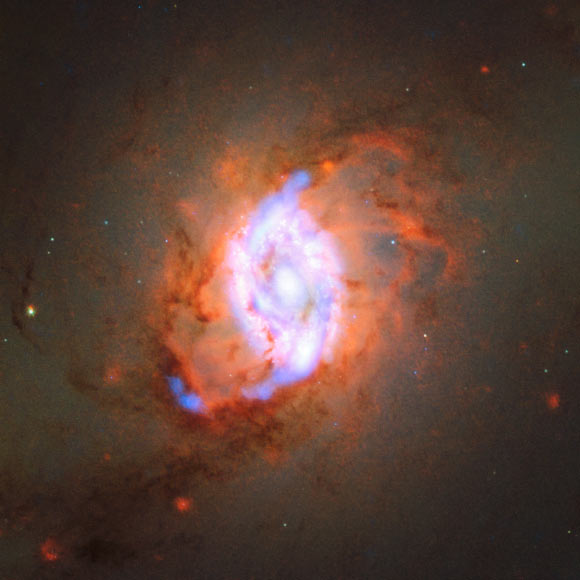Astronomers Observe ‘Stellar Feedback’ in Spiral Galaxy Messier 95 | Astronomy – Sci-News.com
Astronomers have used the Atacama Large Millimeter/submillimeter Array (ALMA), the NASA/ESA Hubble Space Telescope and the Multi Unit Spectroscopic Explorer (MUSE) instrument on ESO’s Very Large Telescope to study a process called stellar feedback in the barred spiral galaxy Messier 95.

This image, which combines data from ALMA, Hubble and MUSE, shows the barred spiral galaxy Messier 95. Image credit: ESO / R. Leaman / D. Gadotti / K. Sandstrom / D. Calzetti.
Messier 95 is located approximately 35 million light-years away in the constellation Leo.
Also known as M95 and NGC 3351, this galaxy was first discovered in 1781 by Pierre Méchain, a French astronomer and surveyor who worked alongside Charles Messier.
Messier 95 is a member of the M96 galaxy group, which also includes the intermediate spiral galaxy Messier 96 and the elliptical galaxy Messier 105.
The galaxy contains around 40 billion stars and has a bar cutting through its center, surrounded by an inner ring currently forming new stars.
Messier 95 is a good laboratory to study stellar feedback, the process of redistributing gas, metals and energy into the interstellar medium within star-forming galaxies.
This process regulates star formation, drives galactic winds, shapes the baryonic and dark structure of galaxies, and is often cited as the biggest uncertainty in galaxy formation models.
To study it in Messier 95, Dr. Ryan Leaman from Max-Planck Institute for Astronomy and colleagues imaged molecular gas and dust in an outflow from the galaxy’s central star-forming ring.
“In Messier 95, star formation is occurring in the ring surrounding the galaxy nucleus at such a violent rate that massive bubbles of hot gas can actually be seen being ejected,” the astronomers explained.
“This ejected gas can then contribute — both positively and negatively — to ongoing star formation within the galaxy.”
The team’s paper was published in the Monthly Notices of the Royal Astronomical Society.
_____
Ryan Leaman et al. 2019. Survival of molecular gas in a stellar feedback-driven outflow witnessed with the MUSE TIMER project and ALMA. MNRAS 488 (3): 3904-3928; doi: 10.1093/mnras/stz1844





